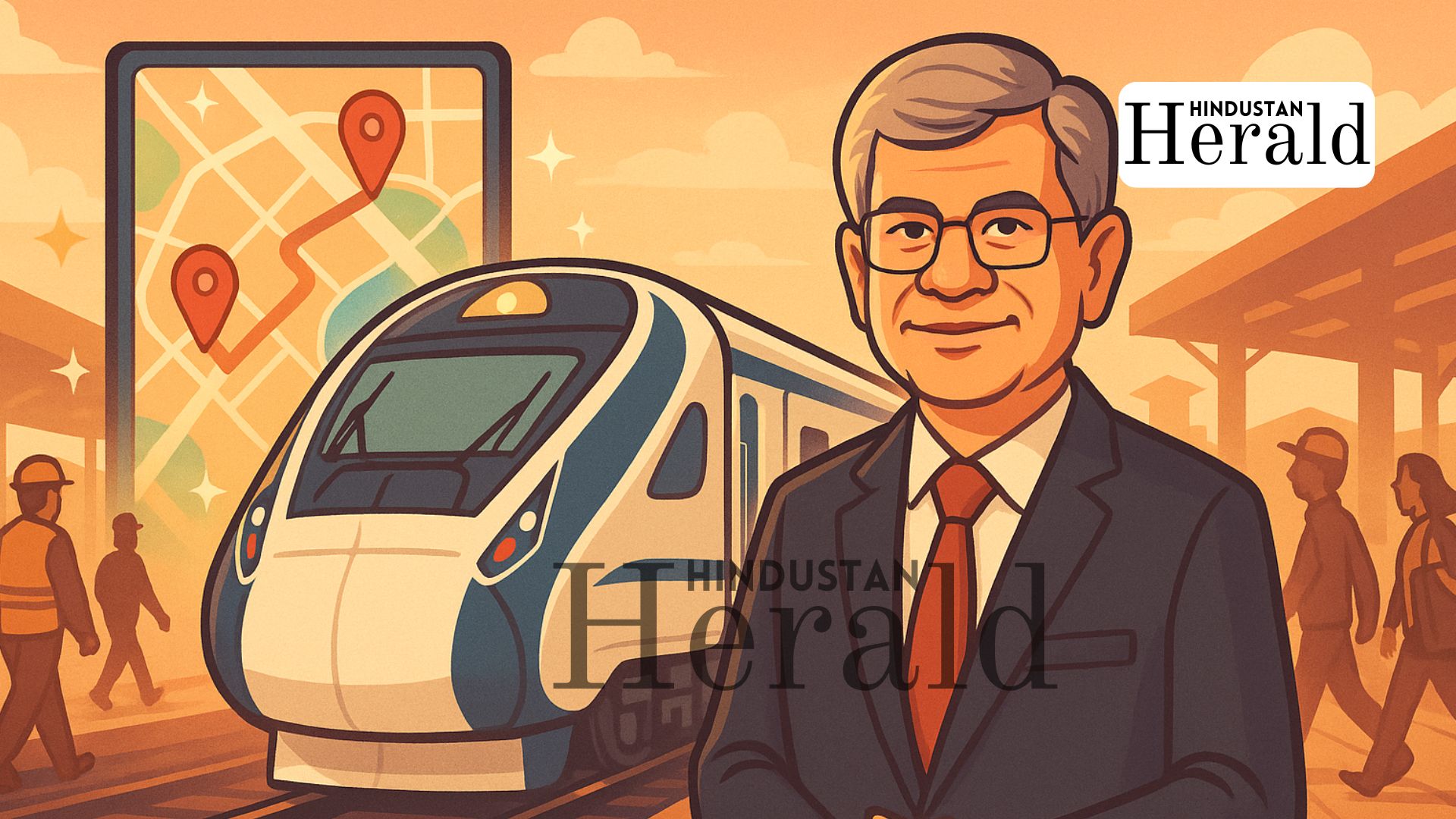New Delhi, October 13: For a system that touches nearly every Indian family, the Railways rarely goes a week without news. But this one felt different. Between new technology tie-ups, tighter ticketing rules, and some worrying safety incidents, the week gone by showed the country’s rail network at a crossroads, caught between digital transformation and the messy realities of everyday travel.
The Mappls Moment: A Homegrown Answer To Google
When Railway Minister Ashwini Vaishnaw took to social media this week to announce an upcoming partnership with Mappls, a navigation app built by MapmyIndia, it wasn’t just a tech update it was a signal. The Railways is preparing to bring India’s own mapping ecosystem into its massive digital footprint.
The details are still under wraps, but officials say the MoU with Mappls will focus on integrating native mapping and navigation across stations, trains, and logistics routes. For passengers, this could mean real-time train tracking without relying on Google Maps; for the system, it’s a way to build data sovereignty into a public network used by millions every day.
The markets picked up the cue instantly. Shares of CE Info Systems, MapmyIndia’s parent company, jumped more than 8%, riding on the minister’s endorsement. Inside Rail Bhavan, the mood is said to be quietly confident that this partnership is being viewed as a statement of intent: that India can build, scale, and trust its own digital tools.
Still, questions linger. Will Mappls’ systems sync smoothly with Railways’ decades-old digital architecture? Can it deliver at the scale of 23 million passengers a day? Those are questions for the coming months.
A New Digital Backbone With Airtel
While Mappls grabbed the headlines, another major deal unfolded more quietly. Airtel Business, the enterprise wing of Bharti Airtel, signed a multi-year agreement to secure and manage Indian Railways’ digital communications network.
This isn’t a flashy consumer partnership; it’s infrastructure deep in the bones of the system. The Railways’ internal network carries everything from real-time signalling data to staff communications and station systems. The Airtel deal, according to The Times of India, covers network monitoring, cybersecurity, and reliability assurance areas that have often gone unnoticed until they fail.
It’s part of a broader shift: the Railways is outsourcing tech-heavy functions to private specialists while retaining control of data and direction. In policy circles, this is being read as the Railways’ “cloud moment,” a sign it wants to modernise without losing autonomy.
Aadhaar Comes To IRCTC: Tightening The Net
Starting October 1, anyone booking tickets on IRCTC during the first 15 minutes of the general reservation window must now verify their identity through Aadhaar. It’s a small procedural change, but one that’s already stirring debate.
Officials say it’s meant to crack down on touting the practice of booking large blocks of tickets through fake accounts and reselling them. The Aadhaar layer, they argue, adds a degree of fairness and accountability to the process.
But critics aren’t so sure. Some privacy advocates have warned that linking national IDs to travel could set a tricky precedent for surveillance and data misuse. The Railways insists that biometric data isn’t stored, only verified. Either way, the message is clear: the era of anonymity in the ticketing system is ending.
The Quiet Overhaul: Fixing What Keeps Trains Running
Beyond passenger-facing reforms, the Railways has been busy fixing the invisible machinery that keeps its 13,000 locomotives on track.
As reported by The Economic Times, the ministry has overhauled the way it handles locomotive shed maintenance, moving to a model based on long-term contracts and strict accountability. The new system, known as Inspection-Maintenance-Confirmation (IMC), expects contractors not just to repair engines but to certify that they’ll perform reliably over time.
In plain terms, it’s a way to make sure maintenance isn’t done for paperwork’s sake. For decades, shed operations have been plagued by delays and patchwork repairs. The IMC model ties payment to performance, a shift that could change how rail workshops across the country function.
It’s not a headline-grabber, but insiders say this reform might be among the most consequential of the year.
Sleeper To General: Managing The Festival Rush
With Diwali and Chhath Puja around the corner, the Railways has authorised zonal managers to convert sleeper coaches into general coaches whenever demand spikes. The move, reported by The Times of India, gives zones freedom to adjust capacity without waiting for central approval.
For ordinary travellers, daily wage earners, migrants heading home, this could mean a slightly less suffocating journey during peak days. For the Railways, it’s another step towards real-time operational flexibility. The decision came after multiple reports of overcrowding in unreserved coaches last year, especially during festival travel.
The Vande Bharat Expands Its Reach
On October 11, a new Vande Bharat Express began running between New Delhi and Patna, cutting the travel time to about 13 hours. The route via Aligarh, Kanpur, Prayagraj, Pt. Deen Dayal Upadhyaya Junction, Buxar, and Ara add a high-speed option to one of North India’s most heavily travelled corridors.
The sleek white-and-blue train has already become a symbol of modernity, but it also reveals a growing class divide within Indian train travel. For middle-class passengers, the Vande Bharat represents comfort and efficiency. For millions still packed into unreserved compartments, it’s a reminder that luxury moves faster.
Accidents And Old Fault Lines
Even as the Railways turn digital, old problems keep resurfacing.
In Bardhaman, West Bengal, eight people were injured after a woman lost her balance on a foot overbridge, causing a small stampede. The Railway Protection Force and station staff responded quickly, but the images from the crowded bridge brought back memories of larger tragedies that have haunted the system.
Meanwhile, in Odisha’s Khurda Road division, trains have hit 252 cattle so far this year, three times more than in 2024, according to The Times of India. The incidents have caused major delays and damage to engines. Authorities have launched fencing and awareness drives, but the problem remains largely rural and behavioural, hard to fix with policy alone.
Down south, a report by Mathrubhumi highlighted another everyday frustration: the 324 level crossings on the Thiruvananthapuram–Mangaluru line. Many crossings still lack overbridges, forcing vehicles to wait for long minutes every time a train passes. In a state known for its density and traffic, the cumulative effect is huge and symptomatic of how rail infrastructure often lags behind local growth.
Between Progress And Pressure
All these stories, the flashy digital MoUs, the long-term maintenance reforms, the small tragedies fit together like a portrait of an organisation in transition. The Railways is trying to become smarter, safer, and more accountable, but its scale keeps it rooted in complications.
For every tech upgrade, there’s a safety scare. For every efficiency policy, a crowd that refuses to think.
Officials talk about “Railways 2.0,” a system that’s digital, responsive, and proud of its indigenous backbone. But on the platforms, under footbridges, and in general coaches, change still moves more slowly than the trains themselves.
The week’s headlines, taken together, tell a simple story: Indian Railways is modernising fast, but the tracks of reform still run through very human terrain, crowded, unpredictable, and constantly on the move.
Stay ahead with Hindustan Herald — bringing you trusted news, sharp analysis, and stories that matter across Politics, Business, Technology, Sports, Entertainment, Lifestyle, and more.
Connect with us on Facebook, Instagram, X (Twitter), LinkedIn, YouTube, and join our Telegram community @hindustanherald for real-time updates.
Covers Indian politics, governance, and policy developments with over a decade of experience in political reporting.






